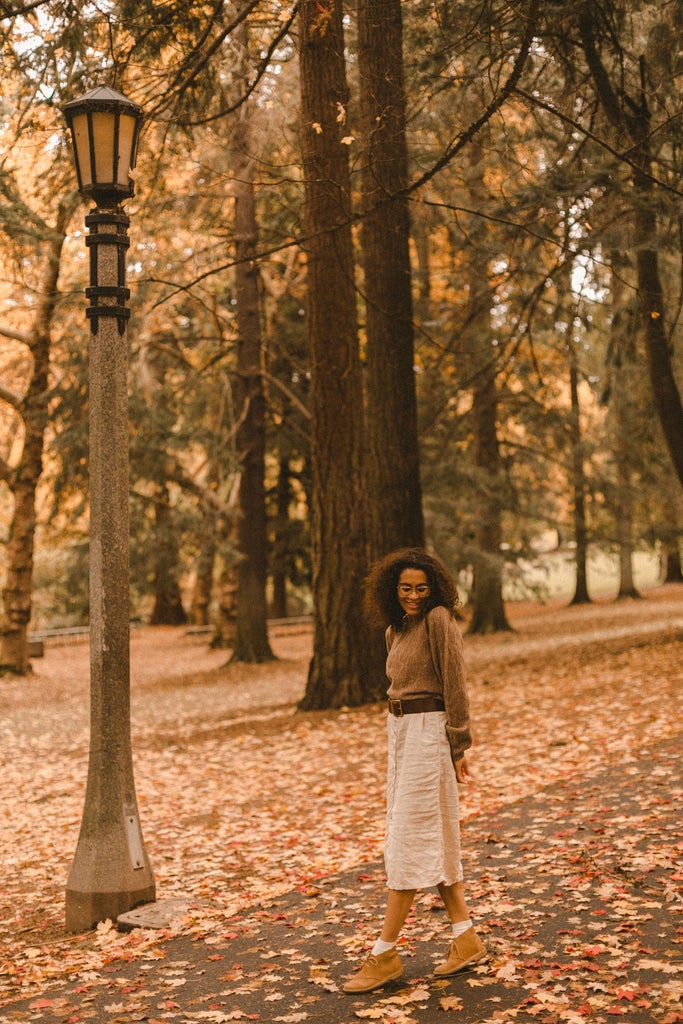These BIPOC Fashion Influencers Are All About Sustainability & People Need To Listen

Sustainable lifestyle influencer Jazmine Rogers started 2020 with around 5,000 followers on Instagram. Today, she has more than 34,000. “I’m happy to connect with a community of like-minded people,” she tells Refinery29 from her home in San Diego. Rogers, who is half-Black and half-Mexican, uses her platform to discuss issues including race and sustainability. While she’s been using her colorful and informative feed to offer resources and tips for years, Rogers says it really feels like people are now listening to what she has to say.
In 2015, Rogers started her blog, That Curly Top, after she joined an anti-human trafficking club in college and learned about the effects of fashion labor trafficking in developing nations where exploitative working conditions and minimal pay are the standard. She documented her experience with quitting fast fashion and dabbled in other forms of sustainable living like reducing her plastic usage and using naturally-made products. That same year, Rogers launched @thatcurlytop on Instagram, which has since replaced her blog. She knows sustainability can be a broad and vague topic — “I love being able to take complex ideas and make it fun and accessible to other people, because [sustainability is] overwhelming” — so Rogers is approaching it from a specific angle: the intersection of sustainability and race. “I’ve leaned towards talking about racial issues and environmental inequities because it’s intertwined with who I am and my communities,” she explains.
The damaging effects of fast fashion became a global lightning rod following the 2013 Rana Plaza factory collapse in Bangladesh. Since then, the fashion industry has been trying to rebuild itself with a sustainable focus. “Ethical” and “sustainable,” especially trendy among millennials and Gen-Z on social media, quickly became buzzwords, but it has been hard for non-white voices and brands to be recognized as part of the conversation.
Up until a few months ago, it took a deep search to find one influencer of color in the sustainability community, yet finding a white influencer was a scroll away. In the wake of George Floyd’s death at the hands of Minneapolis police and the civil rights protests that followed, sustainability influencers of color, like Rogers, have received increased online attention. With the urgency of racial injustice consuming social media, people looked for leading BIPOC voices in different spaces to help inform — and change — perspectives. The sustainability movement was part of the groundswell.
When Aditi Mayer learned about the Rana Plaza disaster, she was taken aback by the grand scale of worker mistreatment in countries like Bangladesh and India. “I started understanding fashion from the politics of labor and the disproportionate impact on people of color globally,” Mayer, who identifies as South Asian, tells Refinery29. Mayer started her blog, ADIMAY, sharing her thoughts on who wasn’t represented in the fashion industry and putting people of color at the forefront of her work. “My vantage points became intersectionality and inclusivity,” the L.A.-based sustainable fashion blogger, photojournalist, and labor rights activist says.
In Mayer’s experience in the industry, “There were many instances of walking into a room and being the only woman of color. If we only have one homogenous group leading this movement, it severely limits the vantage points and modalities through which sustainability and decolonization can take place.” Similarly, when Rogers started her sustainability journey, she couldn’t find many people of color in the space. She also witnessed the lack of opportunities non-white sustainability influencers received: “It was rare for me to see people of color get the same brand deals, collaborations, or speaking positions on panels.”
In June, Rogers’ platform started to grow significantly, but she had feelings of imposter syndrome. “Part of me feels like the only reason I have this following is because I’m half-Black,” she explains. “Am I the cute version of a Black person you want to follow? Or are you actually inclusive and want to listen to all Black voices?” While she grappled with her account’s growth, Rogers’ friends and family reminded her how hard she had worked: “I’ve been doing this for a hot minute, and white influencers who have been in the space just as long as I have skyrocketed. I’m finally getting what I deserve.” She’s also working to expand the community: “I’m finding all these creators I’ve been wanting to find forever. My feed now feels way more diverse.”
Alivia Fields had a different experience growing her audience. The Oregon-based sustainability influencer started her Instagram in 2014, initially to share her photography. When she developed an interest in sustainable living, she transitioned into sharing her lifestyle with her micro-audience in the summer of 2017. During this time, Fields caught the eye of an Instagram executive. After flying down to IG’s headquarters in San Francisco to discuss her process, Fields’ account got put on a “Suggested Users” list for around three weeks. Thanks to the algorithm, Fields’ platform rapidly increased from 300 to 30,000 followers. After the boost, “My career did this complete shift, and I was being contacted by brands I’d always wanted to work with.”

Fields’ platform continued to grow — she’s just shy of 100,000 followers today — but she started to feel like she was the only woman of color in the sustainability space. She remembers working for a brand where her photo had significantly less engagement than photos with white influencers. “Their audience wasn’t used to seeing a person that didn’t fit into a specific look,” she explains. “I was grateful for the opportunities, but I always had this looming thought in the back of my mind of, ‘Am I only here because they had to fill a quota?’”
“I’d like to find a place where the inclusion of diverse influencers is organic and reflexive versus checking a box,” says Cheryl Overton, a New York-based digital diversity strategist. As a fashion brand consultant for over a decade, Overton knows how long it takes for non-white influencers to get mainstream recognition and representation. “They do the heavy lifting but get the lightest return on their effort. They also have to contend with tokenism, unequal pay, lack of opportunities, and microaggressions,” she notes. “We have to see ourselves reflected in the content we consume — it’s inspirational and reflects the world we live in. It’s a powerful tool to shift preconceived notions and expose the public to perspectives they may not otherwise know.”
Like Rogers, Fields attributes the anti-racism movement to her finding more BIPOC sustainability influencers in the past few months. “I might have to seek it out and become friends with a few more people, but it ensures what I’m seeing in my daily life is more inclusive.” She also encourages brands to join this shift on social media. “Getting people used to the idea of seeing other races and cultures is going to be beneficial and powerful,” says Fields.
But diverse inclusion must come from all angles of the industry. “If you’re a brand, demand that BIPOC influencers be considered in your programs. Have BIPOC representation on your teams who can shepherd this work and help make decisions. If you’re an agency, be on the lookout to include diverse talent proactively because their stories and content slap, not because someone thinks it’s trendy. If you’re an ally, ask the client if they’re featuring BIPOC talent for the campaign at the same pay rate,” says Overton. “For systemic bias to be combated, we need all players in the system to participate in reform.”
Mayer agrees that conversations around race and identity need to go beyond this moment in time: “We present an understanding of sustainability that is beyond the marketplace.” Meyer points to platforms like Intersectional Environmentalist, where she is a council member, that share sustainable resources for BIPOC consumers. “We can’t use the excuse of ‘I can’t find them anymore,’ because the resources exist,” she says. “When we’re talking about sustainability, we’re talking about environmental justice, and environmental justice means we’re talking about race and identity.”
Rogers’ following has now allowed her to pursue her sustainability influencer career full-time. “As a woman of color, it’s hard to say I deserve anything, but I’ve put time and energy into educating others, and it’s honoring to finally get that recognition,” she says.
Like what you see? How about some more R29 goodness, right here?
What It Takes For Fashion Brands To Be Sustainable
Meet The Women Decolonizing Sustainable Fashion
For Gen Z, Thrifting Is A Lifestyle
Thanks for reading.
Please Share, Comment, Like the post And Follow, Subscribe CTS Store.
fromSource




Post a Comment